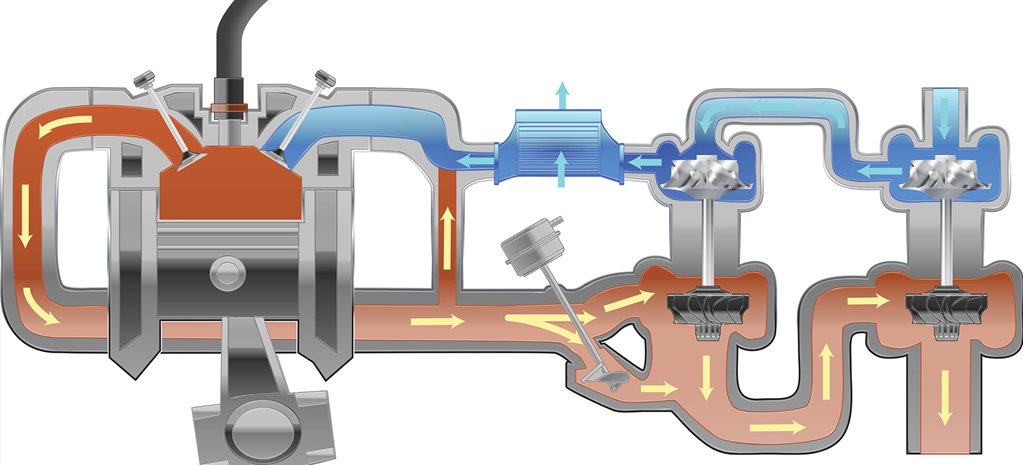4 Easy Facts About Turbochargers Explained
Table of ContentsThe Definitive Guide to TurbochargersNot known Facts About TurbochargersThe smart Trick of Turbochargers That Nobody is Discussing

For example, in Opel bi-turbo Diesel, only the smaller turbocharger works at low speed, providing high torque at 1,5001,700 rpm - turbochargers. Both turbochargers operate together in mid variety, with the smaller sized one pre-compressing the air, which the bigger one more compresses. A bypass valve controls the exhaust circulation to each turbocharger.
Smaller turbochargers have less turbo lag than larger ones, so frequently 2 little turbochargers are utilized rather of one large one. This setup is popular in engines over 2. 5-litres and in V-shape or boxer engines. Twin-scroll or divided turbochargers have 2 exhaust gas inlets and 2 nozzles, a smaller sharper angled one for quick response and a bigger less angled one for peak performance.
In twin-scroll designs, the exhaust manifold physically separates the channels for cylinders that can hinder each other, so that the pulsating exhaust gasses circulation through different spirals (scrolls). With typical shooting order 1342, two scrolls of unequal length pair cylinders 1 and 4, and 3 and 2. This lets the engine effectively use exhaust scavenging methods, which decreases exhaust gas temperatures and emissions, improves turbine performance, and decreases turbo lag apparent at low engine speeds.
The vanes are placed just in front of the turbine like a set of slightly overlapping walls. Their angle is adjusted by an actuator to block or increase air flow to the turbine. This irregularity maintains a comparable exhaust velocity and back pressure throughout the engine's rev variety. The outcome is that the turbocharger enhances fuel performance without an obvious level of turbocharger lag.
The compressor is comprised of an impeller, a diffuser and a volute housing. The operating series of a compressor is described by the "compressor map". The flow variety of a turbocharger compressor can be increased by enabling air to bleed from a ring of holes or a circular groove around the compressor at a point somewhat downstream of the compressor inlet (however far find here nearer to the inlet than to the outlet).
How Turbochargers can Save You Time, Stress, and Money.
It attains this by forcing a simulation of impeller stall to occur constantly. Enabling some air to leave at this area prevents the start of surge and broadens the operating range. While peak efficiencies may decrease, high effectiveness may be accomplished over a greater series of engine speeds. Boosts in compressor performance lead to slightly cooler (more dense) consumption air, which improves power.
The ability of the compressor to supply browse around these guys high increase at low rpm might likewise be increased partially (because near choke conditions the compressor draws air inward through the bleed course). Ported shrouds are utilized by numerous turbocharger makers. The centre hub rotating assembly (CHRA) houses the shaft that connects the compressor impeller and turbine.

Ball bearings designed to support high speeds and temperatures are sometimes utilized rather of fluid bearings to support the turbine shaft. This helps the turbocharger speed up faster and reduces turbo lag. Some variable nozzle turbochargers utilize a rotary electric actuator, which uses a direct stepper motor to open and close the vanes, rather than pneumatic controllers that operate based on air pressure.
When the pressure of the engine's consumption air is increased, its temperature likewise increases. This incident can be discussed through Gay-Lussac's law, stating that the pressure of an offered amount of gas held at consistent volume is directly proportional to the Kelvin temperature level. With more pressure being added to the engine through the turbocharger, overall temperatures of the engine will likewise increase.
The warmer the intake air, the less thick, and this content the less oxygen available for the combustion occasion, which lowers volumetric performance. Not just does extreme intake-air temperature level reduce effectiveness, it likewise causes engine knock, or detonation, which is harmful to engines. To compensate for the increase in temperature, turbocharger units typically make usage of an intercooler between succeeding phases of increase to cool down the consumption air.
The Facts About Turbochargers Uncovered
There are 2 locations on which intercoolers are frequently mounted. turbochargers. It can be either mounted on top, parallel to the engine, or installed near the lower front of the lorry. Top-mount intercoolers setups will result in a reduction in turbo lag, due in part by the place of the intercooler being much closer to the turbocharger outlet and throttle body.
Front-mount intercoolers can have the possible to offer better cooling compared to that of a top-mount. The area in which a top-mounted intercooler is situated, is near one of the most popular locations of a cars and truck, right above the engine. This is why most producers consist of big hood scoops to help feed air to the intercooler while the vehicle is moving, however while idle, the hood scoop provides little to no advantage.
With more distance to travel, the air circulated through a front-mount intercooler might have more time to cool. Methanol/water injection has been around given that the 1920s but was not used till World War II. Including the mix to consumption of the turbocharged engines reduced operating temperature levels and increased horse power.